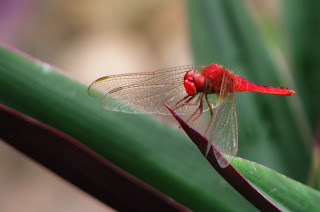
Hummingbird Clearwing Moth: Hemaris thysbe, the Hummingbird Clearwing Moth or Common Clearwing (wingspan 38-50 mm), readily visits flowers by day throughout the eastern half of the U.S. and Canada, where it ranges far to the north, even into the Yukon.
It is not difficult to see why many gardeners would mistake an Hemaris thysbe moth for a small hummingbird as it hovers, sipping nectar from flowers through a long feeding tube. The moth hovers briefly, sipping for only a few seconds before darting off to a new flower. Green body "fur" and burgundy wing scales suggest a small ruby throated hummingbird.
You can see the very similar species in India called Hummingbird Hawk Moth. So next time when you are in a garden watch for it!
Photo: Sanjib Bhattacharyya, France
(Our friend Sanjib has contributed this who also writes this up.)

















































